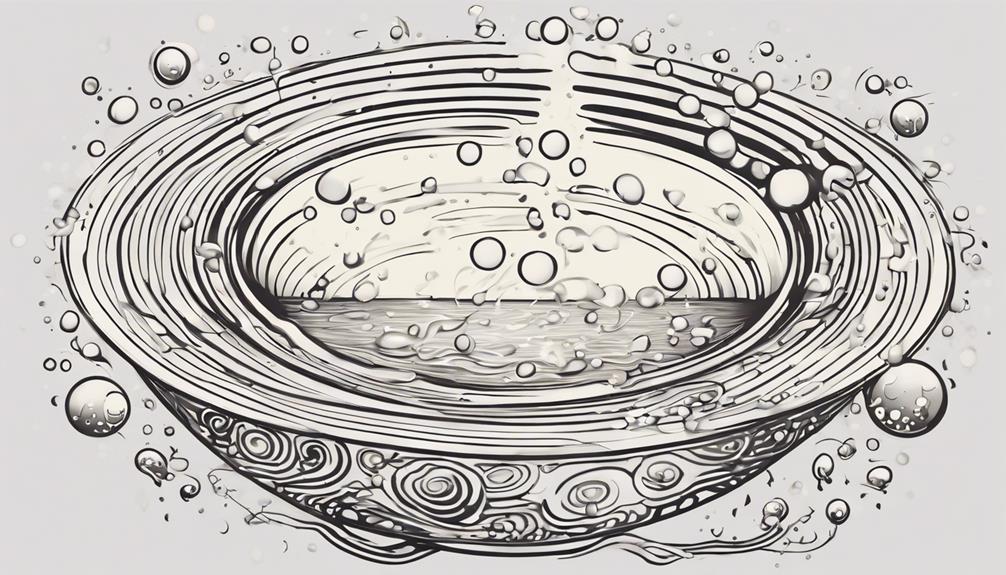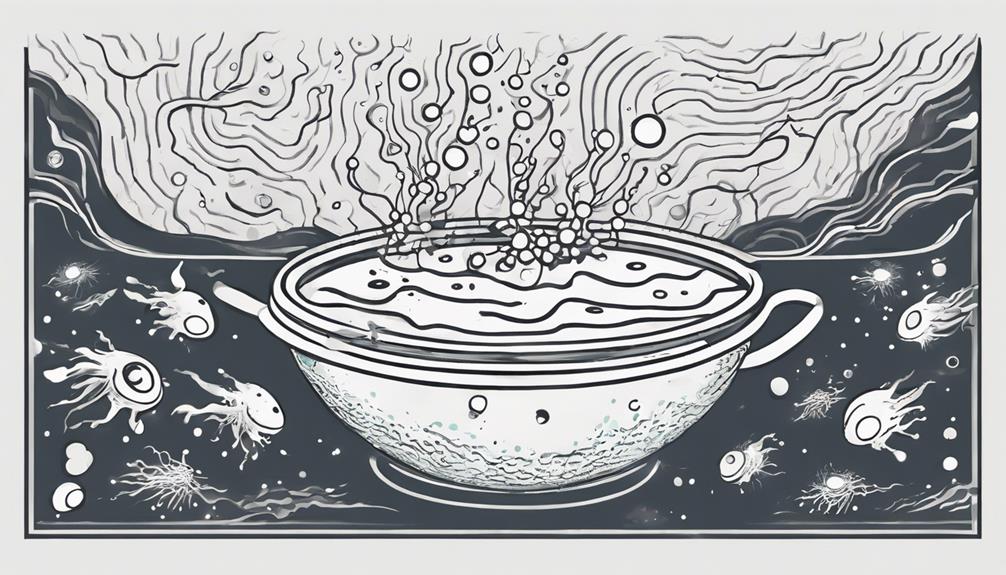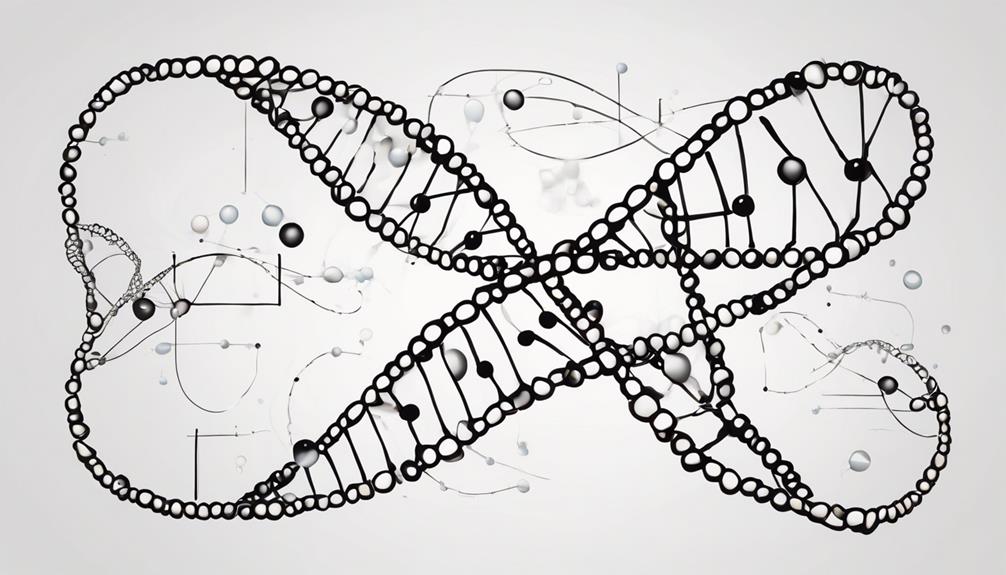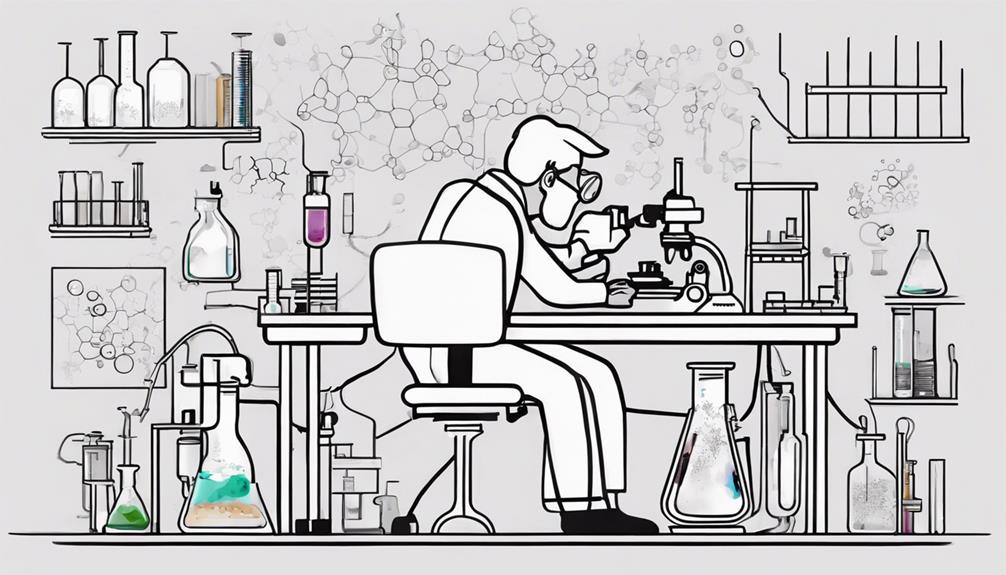The question of how life originated on Earth is a profound mystery that continues to captivate scientists across various disciplines. From the intricate chemistry of the primordial soup to the possibility of extraterrestrial origins through panspermia, the quest to unravel life's beginnings is a journey filled with complex hypotheses and intriguing experiments. As researchers delve into the depths of prebiotic chemistry and the enigmatic world of ancient biomolecules, the story of life's genesis on our planet remains an intricate puzzle waiting to be deciphered, hinting at the awe-inspiring complexity of nature's grand design.
Key Takeaways
- Life on Earth potentially began through RNA, protocells, or metabolism-first pathways.
- Organic molecules in primordial soup, energized by lightning and volcanic activity, could have sparked life.
- Panspermia theory proposes extraterrestrial sources seeding life on Earth.
- Laboratory experiments mimic early Earth conditions to unveil chemical reactions and building blocks crucial for life's origin.
Theories on Life's Origins

Life's origins have long been a subject of intense scientific inquiry, leading to the development of various theories proposing different pathways for the emergence of life on Earth. The RNA World hypothesis suggests that life began with RNA molecules, highlighting RNA's critical role in life's origin. This hypothesis implies that RNA, with its ability to store genetic information and catalyze reactions, may have been the precursor to DNA-based life forms. Furthermore, the idea of protocells as primitive structures that could have initiated life's development adds another layer to the discussion. These protocells are believed to have exhibited some characteristics of life, such as simple reproduction and metabolism, providing a potential starting point for evolutionary processes.
In contrast, the Metabolism-first theory offers an alternative perspective, proposing that life originated from chemical reactions that harnessed energy. This theory challenges traditional views by suggesting that metabolism predated genetic material. Debates surrounding the specific chemical components and processes that kickstarted life underline the complexity of understanding life's origins, fueling ongoing scientific discourse.
Primordial Soup Hypothesis
In the quest to understand the origins of life on Earth, the Primordial Soup Hypothesis stands as a compelling theory proposing the emergence of life from a complex interplay of organic molecules within the early oceans. This hypothesis suggests that Earth's early environment, rich in organic compounds, provided the necessary conditions for the formation of life's building blocks. The famous Miller-Urey experiment in 1953 demonstrated that under simulated early Earth conditions, simple organic molecules could give rise to more complex compounds like amino acids, supporting the idea that the primordial soup could have been the cradle of life. Energy sources such as lightning, UV radiation, and volcanic activity likely played crucial roles in driving the chemical reactions necessary for the transformation of these organic molecules into the precursors of life. The concept of a primordial soup teeming with organic potential remains a prominent theory in the scientific exploration of life's beginnings on Earth.
Panspermia Theory

The Panspermia Theory posits that extraterrestrial sources, such as comets or meteorites, may have brought life to Earth. This theory suggests that life, in the form of microbial organisms or organic molecules, could have been transported through space and deposited on our planet. Panspermia provides a compelling explanation for the presence of complex organic molecules on Earth and the relatively rapid emergence of life. By proposing that life could have originated beyond Earth, panspermia challenges traditional views on the origins of life and raises intriguing questions about the potential for life to exist elsewhere in the universe. Moreover, it sparks discussions about the feasibility of interstellar travel for life forms. While controversial, the panspermia theory offers a unique perspective on the interconnectedness of celestial bodies and the mysterious beginnings of life on our planet. This hypothesis continues to stimulate scientific inquiry into the mysteries surrounding the origins of life.
Miller-Urey Experiment
Challenging traditional perspectives on the origins of life, the Miller-Urey experiment, conducted in 1953, simulated early Earth conditions to investigate the abiotic synthesis of organic compounds.
- The experiment successfully produced amino acids, which are the fundamental building blocks of proteins, by sparking electrical discharges in a mixture of simple gases like methane, ammonia, water vapor, and hydrogen.
- This groundbreaking achievement demonstrated that under the right conditions, organic molecules essential for life could spontaneously form.
- The results of the Miller-Urey experiment provided crucial evidence supporting the concept of abiotic chemistry, suggesting that life's key components could have arisen on a young Earth without the need for biological processes.
- By mimicking the environmental conditions believed to exist on early Earth, this experiment shed light on how the organic compounds necessary for life could have originated, offering valuable insights into the beginnings of life on our planet.
RNA World Hypothesis

The RNA World hypothesis presents a compelling scenario for the origins of life, suggesting that RNA played a crucial role in early chemical evolution. RNA's dual capacity for information storage and catalytic activity hints at its potential as a key player in the transition from simple molecules to complex life forms. By exploring the implications of RNA's capabilities, we can gain valuable insights into the fundamental processes that kickstarted life on Earth.
Rna's Role in Origins
Exploring the origins of life on Earth involves delving into the RNA World hypothesis, which proposes a pivotal role for RNA molecules in the emergence of early life processes.
- RNA's versatility allows for self-replication and catalysis, making it a plausible candidate for the first genetic material.
- RNA's ability to store genetic information and catalyze reactions suggests it could have driven early biochemical pathways.
- The hypothesis suggests RNA predates DNA, indicating a crucial evolutionary step towards complex life forms.
- Research supporting RNA as the first self-replicating molecule strengthens the idea that it kickstarted life's evolution on Earth.
Chemical Evolution Theory
How did the Chemical Evolution Theory, particularly through the RNA World Hypothesis, set the stage for the emergence of life on Earth? The RNA World hypothesis posits that RNA molecules, capable of both storing genetic information and catalyzing reactions, played a fundamental role in the early stages of life. These self-replicating molecules are believed to have been the precursors to more complex structures, potentially preceding DNA in early life forms. RNA's dual functionality in storing genetic material like DNA and catalyzing reactions like proteins made it a prime candidate for kickstarting the evolution of life on our planet. By providing a plausible explanation for the emergence of the first self-replicating and evolving systems billions of years ago, the RNA World hypothesis sheds light on the origins of life as we know it.
Deep-Sea Hydrothermal Vents
Emerging from the depths of the ocean floor, deep-sea hydrothermal vents harbor a dynamic geothermal ecosystem with the potential to shed light on the origins of life on Earth.
- Deep-sea hydrothermal vents are geothermal systems located on the ocean floor where superheated water rich in minerals gushes out, creating a unique environment characterized by high temperatures and extreme pressure.
- The chemical gradients and energy sources present at these vents may have facilitated the formation of essential organic compounds necessary for life to emerge.
- Microorganisms found thriving in these extreme environments provide compelling evidence for the possibility of life originating in such conditions.
- Research suggests that deep-sea hydrothermal vents could have played a crucial role in the early stages of life on Earth, offering insights into how life might have begun in such challenging settings.
These vents stand as a testament to the resilience of life and the remarkable adaptability of organisms in the face of extreme conditions, providing valuable clues to the mystery of life's origins.
Chirality in Biology

Chirality, the asymmetry in molecules that is fundamental to biological processes, stands as a cornerstone in understanding the intricacies of life's molecular architecture. Chiral molecules exist as non-superimposable mirror images, known as enantiomers, with profound implications in biology. From the arrangement of molecules within cells to the transmission of genetic information, chirality plays a pivotal role in shaping biological structures accurately. The specific orientation of chiral molecules is vital for the proper functioning of enzymes, receptors, and other biomolecules essential for life processes.
To illustrate the significance of chirality in biology, consider the following table:
| Aspect | Importance |
|---|---|
| Molecules in Cells | Essential for cellular functions and interactions |
| Genetic Information | Influences the coding and decoding processes |
| Chirality | Determines the specificity of biological molecules |
| Biological Structures | Shapes the architecture of proteins and other compounds |
Understanding chirality is paramount for comprehending the intricacies of biological systems and is crucial for replicating and manipulating biological structures accurately. The biological world heavily relies on the unique properties of chiral molecules for its functioning and development.
Prebiotic Synthesis of Molecules
The prebiotic synthesis of molecules represents a fundamental aspect of unraveling the origins of life on Earth. By investigating the chemical pathways that led to the formation of amino acids, sugars, and nucleotides in prebiotic conditions, scientists aim to understand how life's building blocks emerged from non-living matter. Through experiments simulating early Earth environments and the analysis of extraterrestrial sources, the plausibility of natural chemical processes giving rise to life's essential components becomes increasingly apparent.
Chemical Origins of Life
In the quest to unravel the origins of life on Earth, the study of prebiotic synthesis delves into the chemical pathways leading to the formation of crucial organic molecules such as amino acids and nucleotides.
- Chemical reactions under early Earth conditions facilitated the synthesis of organic compounds essential for life.
- The Miller-Urey experiment demonstrated the possibility of amino acid formation from simple gases, mirroring primordial Earth settings.
- Delivery of organic molecules by interstellar dust clouds likely contributed to the prebiotic synthesis process on Earth.
- Detection of amino acids like glycine in comet material and meteorites supports the notion of prebiotic synthesis occurring beyond Earth, hinting at a universal phenomenon.
Building Blocks Formation
Exploring the genesis of life on Earth necessitates a keen examination of the intricate processes involved in the prebiotic synthesis of essential organic molecules, paving the way for understanding the fundamental building blocks formation required for life's emergence. The first steps towards life involve the synthesis of small molecules like amino acids, nucleotides, and sugars. These molecules are the precursors to more complex organic compounds necessary for life's development. Abiotic processes in environments such as hydrothermal vents and lightning discharges play a crucial role in generating these building blocks. Moreover, extraterrestrial organic materials found in interstellar clouds, including polycyclic aromatic hydrocarbons (PAHs) and amino acids, could have contributed to seeding Earth with essential organic molecules. The plausibility of forming these molecules outside of biological systems showcases the potential for life's chemical origins in non-biological settings.
Laboratory Experiments and Findings

Laboratory experiments in the pursuit of understanding the origins of life have yielded crucial insights into the spontaneous formation of vital biomolecules under early Earth conditions.
- These experiments have successfully produced basic building blocks of life, such as amino acids and nucleotides, in settings mimicking the primordial Earth.
- Findings indicate that complex molecules essential for life, like RNA, can spontaneously form under the specific atmospheric and chemical conditions thought to exist on early Earth.
- By recreating early Earth environments in laboratories, scientists have been able to simulate the processes that might have facilitated the origin of life billions of years ago.
- Research has shown that lipid vesicles, similar to cell membranes, have the ability to self-assemble under certain conditions, providing insights into how primitive cells could have emerged from simple precursors.
These experiments continue to uncover the chemical reactions and pathways that could have kickstarted life on Earth, shedding light on one of the most profound mysteries of science.
Energy and Entropy in Early Life
The utilization of geothermal heat, sunlight, and lightning as energy sources in early life on Earth played a fundamental role in driving essential chemical reactions that contributed to the emergence and evolution of living organisms. Iron-sulfur chemistry, prevalent in deep-sea hydrothermal vents, facilitated the transformation of energy, driving unfavorable processes towards highly favorable ones. Early organisms not only harnessed these energy sources but also played a crucial role in increasing local order while contributing to higher entropy in the overall environment. Experiments and simulations have validated the significance of these energy sources in the emergence of life, highlighting their role in sustaining vital life processes. The second law of thermodynamics underscores the complexity and evolution of life, emphasizing the essential interplay between energy utilization, entropy, and the development of early life processes. Understanding how energy was harnessed and transformed by the first organisms sheds light on the mechanisms that kickstarted life on Earth.
Frequently Asked Questions
How Did Life First Start on Earth?
The question of how life first originated on Earth is a fundamental inquiry that continues to captivate scientific curiosity. Various hypotheses propose different scenarios, from the primordial soup theory, suggesting life emerged from a mix of chemical reactions, to the notion of early organisms evolving through genetic mutations. The evolutionary process of life's inception remains a complex interplay of factors that spark ongoing debate and exploration in the scientific community.
How Did Human Life Begin?
Human life began through a complex evolutionary process involving genetic mutations, ancient ancestors, societal developments, and cultural influences. Evolutionary theories suggest that Homo sapiens, modern humans, emerged around 300,000 years ago in Africa. The development of tools, language, and social structures played vital roles in human evolution. Genetic evidence supports the idea that all modern humans descended from a common ancestor in Africa, highlighting the interconnectedness of human life and evolution.
Where Did the First Life on the Earth Come From?
The question of where the first life on Earth originated from is a fundamental enigma in the realm of scientific inquiry. Various theories propose the primordial soup hypothesis, suggesting that early Earth's chemical reactions in deep sea vents led to the creation of life. Additionally, the panspermia theory posits an extraterrestrial origin of life, proposing that ancient bacteria may have arrived on Earth via meteorite impacts. These theories challenge our understanding of life's beginnings on our planet.
How Did the World Start?
The question of how the world began is a profound inquiry that leads us on a journey through the cosmic event known as the Big Bang. From the primordial soup of early Earth conditions emerged the evolutionary process that laid the groundwork for life's inception. Abiogenesis theories offer insights into the gradual development of living organisms from non-living matter, shedding light on the mysterious origins of life itself.
Conclusion
In conclusion, the enigmatic origins of life on Earth continue to perplex and intrigue scientists worldwide. Through the exploration of various theories and experimental evidence, the quest to unravel the mysteries of life's beginnings remains ongoing. The intricate interplay of chemical processes, environmental conditions, and chance events has shaped the evolutionary trajectory of life on our planet. As researchers delve deeper into the complexities of life's emergence, the puzzle of our existence only becomes more fascinating and elusive.
